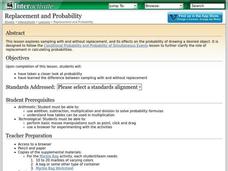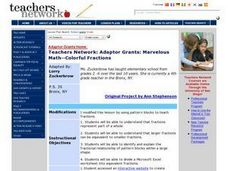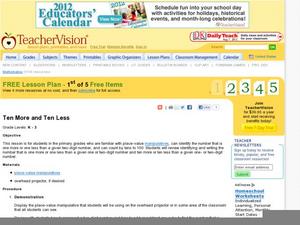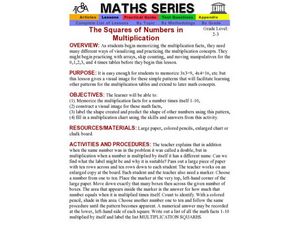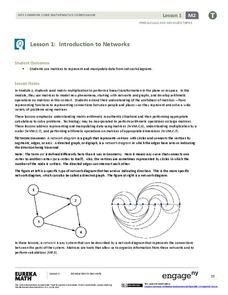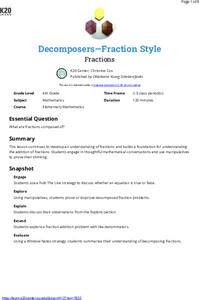Curated OER
Symmetry with Manipulatives
First graders investigate symmetry in patterns by utilizing unifix cubes. In this pattern lesson plan, 1st graders practice creating patterns that are perfectly symmetrical no matter which way it's looked at. Students utilize...
Shodor Education Foundation
Replacement and Probability
Middle and high schoolers explore the concept of probability. In this probability lesson, learners conduct an experiment with a bag of marbles. Pupils draw marbles from a bag and determine the probability of drawing a particular color...
Curated OER
Telling Time With Clocks/Bingo “Time”
Young learners create a clock by adding hands and placing the numbers in the correct location. After each learner has their very own clock, they explore each component. Review on the hour times, and then introduce them to five-minute...
Curated OER
Math/Quilt Connection
Students explore quilting. In this math patterns lesson, students define the perimeter of a quilt border, create tessellations using geometric shapes, and detemine the area of a quilt.
Curated OER
Jack Math Scramble
Students practice throwing and catching jacks to improve their hand-eye coordination. In groups, they participate in a variety of games in which they use the jacks to improve their problem solving skills. To end the lesson, they pick up...
Curated OER
Alien Math
First graders identify combinations and patterns in this lesson. They manipulate an alien picture with 10 arms - 5 red and 5 blue. They use an individual alien picture to identify as many combinations as possible. Students compare...
Curated OER
Best lesson in the whole world!
Students study the concept of fraction using mathematical reasoning. For this problem solving fraction lesson, students use various methods to explain their reasoning in solving fractions. Students use a number of different prompts to...
Curated OER
Marvelous Math -- Colorful Fractions
Students begin the lesson by discovering that a fraction is one part of a whole. In groups, they practice reducting larger fractions into small fractions and discovering they are equal. They use blocks to identify the relationship...
Curated OER
1st Grade Math: Greater Than, Less Than
First graders participate in a variety of math activities that emphasize the concepts of greater than, less than, and equal to. They order numbers on the number line, compare numbers, create letters using numbers on a 1-100 number chart,...
Curated OER
Money Makes the Fair-Go-Round
Learners explore the value of money. In this money lesson plan, students investigating combining amounts of money and making change. Learners count sets of money and make fair trades. Resources are provided.
Curated OER
What's the Best Deal?
Students explore number sense by solving consumer math problems. In this pattern identification lesson, students analyze a list of numerical and geometric patterns while predicting the future outcome. Students utilize inference skills to...
Curated OER
Problem Solving
Fifth graders read and write equations. In this equation writing lesson, 5th graders use real life scenarios to write equations. Students use manipulatives, draw pictures and make tables to understand how to write equations. Students...
Curated OER
Ten More and Ten Less
Get learners to analyze two-digit numbers based on place value, and use manipulatives to add and subtract both 1 and 10. A place value chart is available, and you can project it during guided practice. Through visualizing...
Curated OER
How the West Was One - Three x Four
While this activity provides a motivating and interesting way to review the concept of the order of operations, it involves the use of software called How the West Was One + Three x Four. There are also other resources that are...
Curated OER
Math Manipulative: "Fraction Sticks"
Fifth graders use sets of fraction sticks to color in fractional amounts and determine how to compare pairs of fractions. In this math activity, 5th graders insert the correct symbol given the fractions they are working with....
Curated OER
Reviewing Money
Students review the concepts on money. In this consumer math lesson, students review the vocabulary and value of each coin. Students are shown coins and identify each one's name and value. Students take an included test on the value of...
Curated OER
The Squares of Numbers in Multiplication
Pupils make multiplication squares. In this math lesson, students review their multiplication facts and multiplication strategies. Pupils are introduced to multiplication squares when multiplying a number by itself.
Curated OER
Walk-a-thon
Fifth graders solve word problems. In this math instructional activity, 5th graders read the word problem and determine what is being asked. Students solve the problem and explain how they reached their solution.
Curated OER
Manipulating Graphs
Students graph real life situations. In this graphing lesson, students read situations and write an equation that matches. They graph the situations and analyze the slope and y-intercept
EngageNY
Making Fair Decisions
Life's not fair, but decisions can be. The 17th installment of a 21-part module teaches learners about fair decisions. They use simulations to develop strategies to make fair decisions.
EngageNY
Three-Dimensional Space
How do 2-D properties relate in 3-D? Lead the class in a discussion on how to draw and see relationships of lines and planes in three dimensions. The ability to see these relationships is critical to the further study of volume and...
EngageNY
Introduction to Networks
Watch as matrices break networks down into rows and columns! Individuals learn how a network can be represented as a matrix. They also identify the notation of matrices.
EngageNY
Percent Increase and Decrease
Increase the percent of pupils that are fluent in solving change problems with an activity that asks class members to look at problems that involve either increases or decreases and to express the change in terms of the percent of...
K20 LEARN
Decomposers—Fraction Style: Fractions
"What are fractions composed of?" is the essential question of a lesson designed to enhance understanding and strengthen the foundation of adding fractions. Mathematicians start by discussing what makes an equation true or false,...

